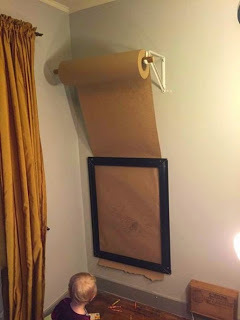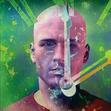Marty Halpern's Blog, page 24
December 18, 2014
Brainstorming
Published on December 18, 2014 12:48
September 10, 2014
Book Received...David Mitchell
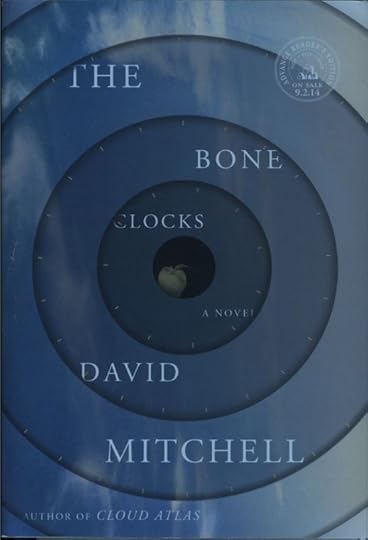 Back in the summer of 2012, when I learned that the Wachowski Brothers' directed Cloud Atlas, starring Tom Hanks and Halle Berry, was to be released in October, I decided it was about time that I read the novel, considering that David Mitchell's
Cloud Atlas
Back in the summer of 2012, when I learned that the Wachowski Brothers' directed Cloud Atlas, starring Tom Hanks and Halle Berry, was to be released in October, I decided it was about time that I read the novel, considering that David Mitchell's
Cloud Atlas
 had been published eight years earlier.
had been published eight years earlier.Cloud Atlas was even one of the few books I added to my Goodreads shelf -- that's how intrigued I was with the prospect of finally reading this book. The story is divided into seemingly unrelated sections: The Pacific Journal of Adam Ewing, Letters from Zedelghem, Half-Lives: The First Luisa Rey Mystery, and The Ghastly Ordeal of Timothy Cavendish -- all well-written and as intriguing as I had hoped: great stuff. Then I got to the section An Orison of Sonmi-451 -- an interview with a genetically engineered fabricant. And the interview seemed to go on and on and... and I became bored and set the book down. Never to pick it up again. In fact, just the other day I realized the title was still listed as being read on my Goodreads shelf, about two years later! (P.S. I haven't seen the movie yet either; I'll wait now for it to be available on cable.)
But, I'm not giving up on David Mitchell, and, in fact, courtesy of Suvudu.com, I now have an Advance Reader's Edition of The Bone Clocks
 to read at my leisure.
to read at my leisure.Here's an excerpt from the publisher's PR sheet that was inside the book:
Following a scalding row with her mother, fifteen-year-old Holly Sykes slams the door on her old life. But Holly is no typical teenage runaway: A sensitive child once contacted by voices she knew only as "the radio people," Holly is a lightning rod for psychic phenomena, and she has caught the attention of a cabal of dangerous mystics—and their enemies. But her lost weekend is merely the prelude to a shocking disappearance that leaves her family irrevocably scarred. This unsolved mystery will echo through every decade of Holly's life, affecting all the people Holly loves—even the ones who are not yet born. A Cambridge scholarship boy grooming himself for wealth and influence; a conflicted father who feels alive only while reporting from occupied Iraq; a middle-aged writer mourning his exile from the bestseller list—all have a part to play in this surreal, invisible war on the margins of our world.Mitchell's writing has that underlying element of the "fantastic" -- science fiction in Cloud Atlas, and evidently the supernatural in The Bone Clocks -- and yet, his fiction is considered "mainstream," as is the fiction of W. P. Kinsella, whom I wrote about here, and Kazuo Ishiguro, whom I wrote about here, to name only two others. And gawd help us if we should ever refer to these individuals as science fiction writers.

Published on September 10, 2014 15:25
September 5, 2014
The Children of Old Leech Anthology: Excerpts
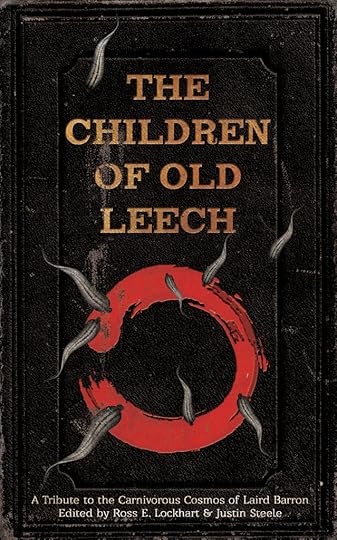 Press Release: The Children of Old Leech: A Tribute to the Carnivorous Cosmos of Laird Barron
Press Release: The Children of Old Leech: A Tribute to the Carnivorous Cosmos of Laird BarronPETALUMA, CALIFORNIA–Word Horde is proud to announce the release of The Children of Old Leech: A Tribute to the Carnivorous Cosmos of Laird Barron
 . Editors Ross E. Lockhart (The Book of Cthulhu, Tales of Jack the Ripper) and Justin Steele (The Arkham Digest) have gathered together many of the brightest lights in dark fiction to pay homage to one of horror's masters.
. Editors Ross E. Lockhart (The Book of Cthulhu, Tales of Jack the Ripper) and Justin Steele (The Arkham Digest) have gathered together many of the brightest lights in dark fiction to pay homage to one of horror's masters.Over the past decade, Laird Barron has become one of the most lauded and influential names in horror fiction. His short stories, two novels, and three collections have garnered numerous nominations and awards, including three Shirley Jackson Awards and a Bram Stoker Award. Recognizing Barron's meteoric rise, Lockhart and Steele sought to assemble an original tribute anthology unlike any other, focusing on atmosphere and affect, rather than simple pastiche.
"Barron's fiction has long been an inspiration to his peers," says co-editor Justin Steele. "The interwoven stories and novels create a rich tapestry of noir-infused cosmic horror. This mythology makes for an excellent backdrop for the weird tales within." Offered this unique opportunity to play in what Publishers Weekly calls Barron's "worm-riddled literary playground," these children of Old Leech—Barron's fans, peers, friends—conjured an anthology "with a coherent feeling of dread, without feeling derivative of the source."
The Children of Old Leech is distributed by Ingram, and will be available in Hardcover and eBook formats through most online retailers and better independent bookstores everywhere in July 2014. For more information about Word Horde or to request an electronic review copy, please email publicity[at]wordhorde[dot]com.
* * * *
On April 24 I wrote about copy editing The Children of Old Leech for Word Horde; and then on July 5 I posted details on the deluxe edition of TCoOL, of which only 100 numbered copies were made available for sale.
In celebration of the release of TCoOL on July 15, excerpts from each of the stories were published on the Word Horde blog over a span of weeks. All of the excerpts have now been posted.
Here is the contents list for The Children of Old Leech:
Introduction: Of Whisky and Doppelgängers — Justin Steele
The Harrow — Gemma Files
Pale Apostle — J. T. Glover & Jesse Bullington
Walpurgisnacht — Orrin Grey
Learn to Kill — Michael Cisco
Good Lord, Show Me the Way — Molly Tanzer
Snake Wine — Jeffrey Thomas
Love Songs from the Hydrogen Jukebox — T.E. Grau
The Old Pageant — Richard Gavin
Notes for "The Barn in the Wild" — Paul Tremblay
Firedancing — Michael Griffin
The Golden Stars at Night — Allyson Bird
The Last Crossroads on a Calendar of
Yesterdays — Joseph S. Pulver, Sr.
The Woman in the Wood — Daniel Mills
Brushdogs — Stephen Graham Jones
Ymir — John Langan
Of a Thousand Cuts — Cody Goodfellow
Tenebrionidae — Scott Nicolay & Jesse James Douthit-Nicolay
Afterword — Ross E. Lockhart
The first story excerpt is "The Harrow" by Gemma Files; at the bottom of this excerpt you will find a link to the next story, and so on, through the entire contents list. I would normally say something to the effect of "Enjoy the read!" -- but "enjoy" isn't quite the word one would use when it comes to Laird Barron's work, or the work of those writing in Barron's world. In my earlier blog post on copy editing this anthology I used the phrase "a feeling of dread, of impending doom..." So read at your own risk....
If you are a fan of Laird Barron's writing, then you will definitely want to read these stories. If you are a reader of dark fantasy -- very dark fantasy! -- and you are new to the world of Laird Barron, then you should be reading these stories.

Published on September 05, 2014 11:33
August 26, 2014
Editing in Process...The Very Best of W. P. Kinsella
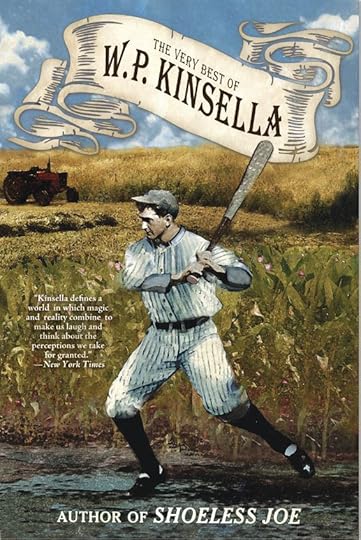 Cover art by Thomas CantyIf you read this blog fairly regularly, you'll recall my post earlier in the month when I wrote about purchasing the Xcanex Professional Book and Document Scanner by piQx imaging. In that post I mentioned a huge scanning project I had begun working on at the time, which is why I was in a bit of a kerfuffle over scanners -- and the fact that my go-to scanner for nearly 10 years no longer worked with OmniPage Pro and Windows 7.
Cover art by Thomas CantyIf you read this blog fairly regularly, you'll recall my post earlier in the month when I wrote about purchasing the Xcanex Professional Book and Document Scanner by piQx imaging. In that post I mentioned a huge scanning project I had begun working on at the time, which is why I was in a bit of a kerfuffle over scanners -- and the fact that my go-to scanner for nearly 10 years no longer worked with OmniPage Pro and Windows 7.That scanning project is short story collection The Very Best of W. P. Kinsella
 , forthcoming in 2015 from Tachyon Publications.
, forthcoming in 2015 from Tachyon Publications.And the project is indeed huge: approximately 138,000 words of fiction, all of which has to be scanned, then cleaned up and formatted, and finally copy edited.
If you've seen the movie Field of Dreams (1989), starring Kevin Costner, then you've experienced a wee taste of W. P. Kinsella, who wrote the novel Shoeless Joe (1982), upon which the movie is based. And Kinsella's novel is an expansion of his 1979 short story, "Shoeless Joe Jackson Comes to Iowa" -- which is included in this Very Best of collection. In the story, a corn farmer in Iowa hears a voice:
Two years ago at dusk on a spring evening, when the sky was a robin's-egg blue and the wind as soft as a day-old chick, as I was sitting on the verandah of my farm home in eastern Iowa, a voice very clearly said to me, "If you build it, he will come."The "he" in "he will come" is Joseph Jefferson Jackson, the "Shoeless Joe Jackson" in the title, one of the greatest baseball outfielders of all time -- who had passed away in 1951, years (and years) before our Iowa corn farmer heard that voice. But if our farmer builds that ballfield, he will come. [Note: Shoeless Joe had been mired in the Black Sox Scandal after the Chicago White Sox lost to the Cincinnati Reds in the 1919 World Series; Joe and seven other teammates were banned for life from baseball the following year.]
The voice was that of a ballpark announcer. As he spoke, I instantly envisioned the finished product I knew I was being asked to conceive. I could see the dark, squarish speakers, like ancient sailors' hats, attached to aluminum-painted light standards that glowed down into a baseball field, my present position being directly behind home plate.
There are a few other baseball stories in this collection, but you don't need to know anything about baseball to enjoy these tales: baseball merely serves as a backdrop to these stories, which are about life and the human condition, often with a bit of the "fantastic" thrown in. My favorite story in the collection is "K Mart" -- but don't let the title fool you: it's the story of lost childhood love, nostalgia, and survival, all amidst the backdrop of a neighborhood dirt-lot baseball game, a game that seemed endless (to the children playing it), but only lasted throughout the summer months.
W. P. Kinsella is also well-known for his "First Nation" stories about the indigenous Cree on the Hobbema Reserve near Edmonton, Canada. These stories reflect the Cree's destitute and disadvantaged culture, yet add an element of humor by exploring the convoluted situations (and shenanigans) they get into trying to survive in a world dominated by white people. But even with the element of humor, there is a sadness to all of these stories. What is especially delightful about these stories is that Kinsella's characters -- Silas (the narrator), Frank Fencepost, Mad Etta, Bedelia Coyote, Sadie One-wound, and Rufus Firstrider, to name just a few -- appear in all the stories. By the time you finish reading this collection, you'll certainly consider them acquaintances, if not friends. In "Beef," Bedelia Coyote determines that a treaty the Cree signed with the Canadian government in the 1800s is still valid, and she files the necessary paperwork so that the reserve receives financial compensation. But Frank Fencepost has a better scheme in mind: he hijacks the paperwork and requests the government honor the compensation put forth in the original treaty: cattle -- figuring he can make more from the cattle than the money the government was offering. The title of the story, "Beef," says it all.
Other stories include the ability to transcend art, literally ("The Grecian Urn"); removing deceased family members, over time, from the family portrait ("Out of the Picture"); gangs, a bikers' bar, and undercover cops ("King of the Street"); and a restaurant where one never gets served ("Waiting on Lombard Street"); and many more. Thirty-one stories in all. Here's the complete contents list, in alphabetical order:
The Alligator Report—with Questions for Discussion
Beef
Brother Frank’s Gospel Hour
Distances
Do Not Abandon Me
Doves and Proverbs
Dr. Don
The Firefighter
First Names and Empty Pockets
The Fog
The Grecian Urn
How I Got My Nickname
How Manny Embarquadero Overcame and Began His Climb
to the Major Leagues
The Indian Nation Cultural Exchange Program
The Job
K Mart
King of the Street
The Last Surviving Member of the Japanese Victory Society
Lieberman in Love
The Lightning Birds
The Lime Tree
Marco in Paradise
The Night Manny Mota Tied the Record
Out of the Picture
Punchlines
Risk Takers
Searching for January
Shoeless Joe Jackson Comes to Iowa
Truth
Waiting on Lombard Street
Wavelengths
"Few writers can match Kinsella's ability to establish tone, character, and a complete reality in just a few paragraphs, then sweep the reader into his imagined world."—Library Journal
"[Kinsella] uses baseball not so much as a metaphor, but as a familiar starting place for exploring, with pinpoint control, the human psyche."—Booklist

Published on August 26, 2014 18:07
August 21, 2014
Austin Musician Suzanna Choffel
So I was channel surfacing last night at about 8:30pm, looking for something to watch for a half hour, and I saw a listing in the paper for "Austin Musicians" on San Mateo's PBS station, KCSM. So I hit the remote for cable channel 17. The show was an hour-long broadcast of the 2013 All ATX concert at the Moody Theater in Austin, a benefit to support the Health Alliance for Austin Musicians (HAAM).
Fortunately, I turned on the TV just in time to catch musician Suzanna Choffel's two-song performance, the latter of which, entitled "Raincloud," absolutely knocked my figurative socks off. I spent some time this morning searching for more info on Ms. Choffel, and learned that she was a performer on NBC's The Voice a few years back, losing in the "knockout" round to a singer who I thought (having watched both performances on YouTube) was (aside from being occasionally off-key) derivative of nearly every other female singer one hears on contemporary pop radio. Anyhow, Ms. Choffel said about her loss: "I was definitely the wild card of the show, doing folk, pop, and reggae, and that may have hurt me in the end, but it's who I am."
I also found on YouTube what appears to be an audience recording of "Raincloud" from the All ATX concert, but the quality is quite poor; so, searching for the song itself, I found a superb version performed "live" at Austin's The Sessions production company. Enjoy!
I checked out Suzanna Choffel's albums -- her latest, Archer, includes "Raincloud" -- but I was disappointed: the sultry, raw quality of her vocals and fretwork are lost, sadly, in the music's overproduction. If she were to release a live album, I'd snatch it up in a digital minute!
Other performers at the All ATX concert included Marcia Ball, Christopher Cross, Eric Johnson, the Sexton brothers, and Jimmy Vaughan, to name but a few. The Austin Chronicle had a fairly decent review of the concert the following day.
Note: Ms. Choffel currently resides in NYC.

Fortunately, I turned on the TV just in time to catch musician Suzanna Choffel's two-song performance, the latter of which, entitled "Raincloud," absolutely knocked my figurative socks off. I spent some time this morning searching for more info on Ms. Choffel, and learned that she was a performer on NBC's The Voice a few years back, losing in the "knockout" round to a singer who I thought (having watched both performances on YouTube) was (aside from being occasionally off-key) derivative of nearly every other female singer one hears on contemporary pop radio. Anyhow, Ms. Choffel said about her loss: "I was definitely the wild card of the show, doing folk, pop, and reggae, and that may have hurt me in the end, but it's who I am."
I also found on YouTube what appears to be an audience recording of "Raincloud" from the All ATX concert, but the quality is quite poor; so, searching for the song itself, I found a superb version performed "live" at Austin's The Sessions production company. Enjoy!
I checked out Suzanna Choffel's albums -- her latest, Archer, includes "Raincloud" -- but I was disappointed: the sultry, raw quality of her vocals and fretwork are lost, sadly, in the music's overproduction. If she were to release a live album, I'd snatch it up in a digital minute!
Other performers at the All ATX concert included Marcia Ball, Christopher Cross, Eric Johnson, the Sexton brothers, and Jimmy Vaughan, to name but a few. The Austin Chronicle had a fairly decent review of the concert the following day.
Note: Ms. Choffel currently resides in NYC.

Published on August 21, 2014 17:10
August 6, 2014
Xcanex Professional Book & Document Scanner
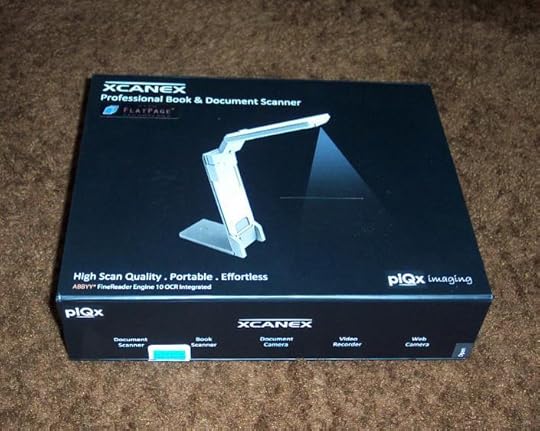 The first flatbed scanner I purchased was a Microtek brand, I'm guessing about a dozen years ago. I was running Windows ME (Millennium, remember that short-lived OS?) at the time and the Microtek scanner worked like a charm. Of course, as is the way of all things technical, I decided to upgrade to Windows XP in 2005.
The first flatbed scanner I purchased was a Microtek brand, I'm guessing about a dozen years ago. I was running Windows ME (Millennium, remember that short-lived OS?) at the time and the Microtek scanner worked like a charm. Of course, as is the way of all things technical, I decided to upgrade to Windows XP in 2005.I purchased the XP system discs and, with the help of my friend Randy (the same person who helped me design my first desktop years earlier, which I wrote about here), I wiped the hard drive and installed Windows XP. I then spent the next two days installing all my software and hardware. Around the end of day two the OS started behaving badly and I couldn't figure out what the problem was. I'll admit I was in a hurry to get the new system up and running, and I didn't keep track of what I installed when, I didn't create restore points, and I didn't test the system after each install. Silly me.... So, back to square one: I wiped the hard drive myself and reinstalled XP, and began the arduous task of installing hardware and software correctly. I created a restore point before each install, I rebooted and tested the system after each install, and I kept a running list of what I installed at each point. Instead of two days, this "best practice" process took me about four days -- at which point everything started behaving flaky again. After some investigation, reverting to restore points, reinstalling some things yet again, I determined that the Microtek driver for the scanner was crashing XP.
I clicked on over to the Microtek website only to discover that they did not support Windows XP on this particular scanner; I guess their developers were too bloody lazy to update the Windows ME driver -- but I bet they sure would like to sell me a new scanner that works under Windows XP! What we call built-in obsolescence! Well, if I'm going to have to dump a perfectly good, working scanner to buy a new one that works with Windows XP, I certainly will not give any more money to Microtek. You would think these corp. idiots would learn....
 So after some research I purchased a Canon CanoScan 4200F flatbed scanner -- which is even better than the Microtek and has served me far longer. The beauty of this CanoScan is the hinged lid that allows you to place an open book face down on the glass and still be able to place the lid on the book. I used this scanner with Nuance's OmniPage Professional -- first OmniPage Pro 12, then I upgraded to 14, then 16, then 17, and finally 18. (Note: Version 18 has a lot of glitches at startup which Nuance has simply refused to address (or even respond to on their own community forum) since they've now moved on to an even bigger and better version -- and because of this, my days of upgrading have ceased with version 18. These tech companies can really be a pain in the behind.) I've been using one version or another of OmniPage Pro and the CanoScan scanner for nearly ten years. The scanner has performed flawlessly.
So after some research I purchased a Canon CanoScan 4200F flatbed scanner -- which is even better than the Microtek and has served me far longer. The beauty of this CanoScan is the hinged lid that allows you to place an open book face down on the glass and still be able to place the lid on the book. I used this scanner with Nuance's OmniPage Professional -- first OmniPage Pro 12, then I upgraded to 14, then 16, then 17, and finally 18. (Note: Version 18 has a lot of glitches at startup which Nuance has simply refused to address (or even respond to on their own community forum) since they've now moved on to an even bigger and better version -- and because of this, my days of upgrading have ceased with version 18. These tech companies can really be a pain in the behind.) I've been using one version or another of OmniPage Pro and the CanoScan scanner for nearly ten years. The scanner has performed flawlessly.The flatbed scanner on my Epson Workforce WF-3540 all-in-one printer was recognized (it uses a WIA driver rather than a TWAIN driver) and worked well with OmniPage so I wasn't in panic mode -- just yet (but I did have a new 100,000-plus word scanning project on my desk, demanding for my attention).
Time to research yet again for another scanner. I was partial to the Canon scanner with the hinged lid -- and, in fact, during my research, Canon announced a new model, the LiDE 220 Color Image scanner, which seemed to fit my needs perfectly. Unfortunately, this was just an announcement, and upon telephoning Canon's marketing division, they weren't even able to provide me with an availability date as yet. The problem with a flatbed scanner is that I tend to damage the spine of the book, particularly a fat trade paperback, because the book must be pressed flat -- very flat -- against the glass to avoid the dark shadow along the gutter; and this shadow can easily interfere with the text on one or both pages.
 Xcanex Professional Book &
Xcanex Professional Book &Document Scanner
Keep in mind I hadn't looked at scanners in nearly ten years, so I was surprised to see this new type of scanner: one designed for books, that allows the books to be scanned face up -- not pressed face down against a sheet of glass.
While checking out this new style of book and document scanner, I found a high-end Fujitsu model (nearly $600.00), which was way above my price range; and a lower-end IPEVO model (just under $100.00), which didn't quite do what I needed such a scanner to do. Enter the Xcanex Professional Book and Document Scanner
 by piQx imaging of Singapore.
by piQx imaging of Singapore.As you can see from the open box pictured above, there are only two main parts to the Xcanex -- five parts if you count the USB cable (from which the scanner also gets its power), the blue guide board, and the software disc (these are not shown; they fit in the box under the two main parts layer). What is especially unique about this scanner -- though I have not tried this myself -- is that it can be attached to a laptop; the imaging part then folds down onto the top of the laptop thus making it portable.
The secret to a successful scan using the Xcanex is the placement of the book on the guide board. Unfortunately, I didn't realize this at first. I was placing the book on the guide board incorrectly -- based on a statement I had thought I had read in the manual -- resulting in scans that the software was unable to correctly recognize. The company has provided a multitude of YouTube videos that show various uses and operations of the Xcanex, but none of the vids focused on the actual placement of the book on the guide board.
I was just about to give up: I already had the scanner packed up for its return shipment... but I hate to let technology get the better of me. So I posted an entry to piQx imaging's Xcanex Forum and asked that they record the entire scanning process, from start to finish, showing that the Xcanex software -- called PerfeCapture -- recognizes each page correctly before and after each scan. And considering how much time the tech support person had already directed my way in response to all my questions and issues, I really wasn't surprised when, the next day, the following video was posted:
If you prefer a higher resolution vid, you can view the video direct from Dropbox (you do not need a Dropbox account). This is a "wmv" video file; Windows systems should have no problem viewing it; as to Macs, well, good luck.
So I unpacked the scanner again and gave it another try. And yet, I was still having problems. My wife, Diane, happened to pass by the room, so I called her in and showed her the problem I was having. She made a casual suggestion to move the book farther down (away from the silver guides on the edge of the guide board, whereas I had the book against the silver guides, which is what I had recalled reading) -- and, lo and behold, the imaging, and the software, worked perfectly. Duh!
I then used the scanner to scan five different stories from three different books (one hardcover and two trade paperbacks) as part of the current project I was now working on -- and except for a couple hiccups (like my not having the page flipped and the book set when the camera clicked for the next scan), everything worked flawlessly.
And when I have to scan one of those monster Year's Best best volumes, and the curve of the gutter is just too great for even the Xcanex to handle open-faced, I can turn the book sideways and scan all the left-facing pages, then turn the book around and scan all the right-facing pages, and the PerfeCapture software is intelligent enough to be able to integrate the left and right pages accordingly.
The Xcanex software also comes with ABBYY FineReader 10 OCR (optical character recognition) software. I had previously tested FineReader (when I became frustrated with the behavior of OmniPage Pro 18), but I wasn't happy with the results -- and even considering the initial problems opening OmniPage Pro 18, I still prefer it over the competition. But, with the PerfeCapture software, I save my scans as a PDF file that has been OCR'd using its built-in ABBYY FineReader software, I then load the PDF into OmniPage and let it do its OCR thing as well, and hopefully the resulting Word file is that much cleaner.

Published on August 06, 2014 13:45
July 28, 2014
Book Received... Daryl Gregory
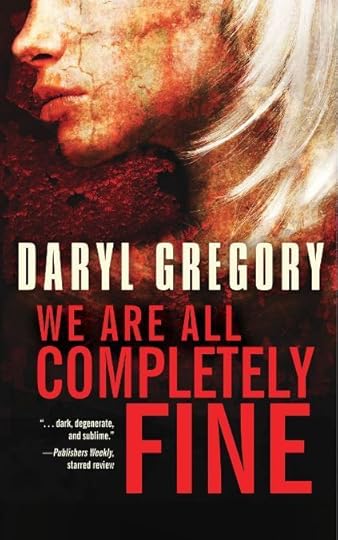 Back in February, I wrote about working on Daryl Gregory's "sharp-edged" novella We Are All Completely Fine -- and even included a very brief excerpt from the story in order to make my point.
Back in February, I wrote about working on Daryl Gregory's "sharp-edged" novella We Are All Completely Fine -- and even included a very brief excerpt from the story in order to make my point.As I said, that was earlier (you can read that blog post here) -- and this is now: We Are All Completely Fine
 is available ahead of schedule direct from the publisher, Tachyon Publications, or your preferred retail bookseller.
is available ahead of schedule direct from the publisher, Tachyon Publications, or your preferred retail bookseller.In fact, I can think of no other active independent publisher that is consistently on schedule -- actually, ahead of schedule -- for every single book that they publish. That's Tachyon Publications. (And, Gawd bless them, they pay on time, too -- every single time! And have done so, since 2002, when I worked on that very first book for them. Writers, keep that in mind when you are considering your next novella, novel, or collection submission, and are looking for a quality publisher.)
If you are not familiar with Daryl Gregory's work, then We Are All Completely Fine is a good place to start; if you are a fan of his work, then I don't need to say anything further: you've most likely had this book on order since you first learned about it. In fact, I believe we'll be seeing this novella on many awards lists beginning in early 2015. Yes, he's that good.

Published on July 28, 2014 14:30
July 12, 2014
Tommy Ramone, January 29, 1949–July 11, 2014
Thomas Erdelyi -- better known by his stage name Tommy Ramone -- was a co-founder of the seminal punk band The Ramones and the last surviving member of the original group. The New York Times obituary.

Published on July 12, 2014 16:23
July 5, 2014
Book Received...The Children of Old Leech Anthology
 When I first wrote about my involvement (here) in
The Children of Old Leech
When I first wrote about my involvement (here) in
The Children of Old Leech
 anthology -- the newest title from publisher Word Horde -- I also recommended at the time that readers opt for the Deluxe Pack available direct from the publisher's web site. As only 100 numbered Deluxe Packs were made, they sold out fairly quickly. I'll post some of the items below, but keep this in mind in the future: When Word Horde offers a deluxe package for one of their books -- snag it!
anthology -- the newest title from publisher Word Horde -- I also recommended at the time that readers opt for the Deluxe Pack available direct from the publisher's web site. As only 100 numbered Deluxe Packs were made, they sold out fairly quickly. I'll post some of the items below, but keep this in mind in the future: When Word Horde offers a deluxe package for one of their books -- snag it!The Children of Old Leech (TCoOL) isn't just another themed anthology. The book's subtitle is the reveal: "A Tribute to the Carnivorous Cosmos of Laird Barron." That previous blog post I mentioned above has some of my thoughts on Laird Barron and TCoOL as well as a list of the book's 17 stories. But a list of stories is just that: a list.
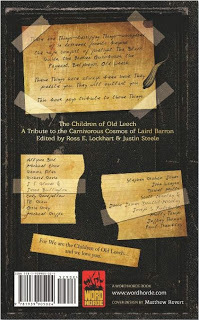 The truth, of course, is in the content: courtesy of publisher Ross E. Lockhart and the 19 TCoOL authors, the Word Horde web site will present a brief excerpt from each of the 17 stories, beginning with "The Harrow" by Gemma Files (on July 2) and continuing every Monday, Wednesday, and Friday over the next few weeks. So if you are still fence-sitting and haven't purchased a copy of TCoOL as yet, please do check out these mini excerpts from all 17 stories. But, lest we forget, it's the mind -- and writing -- of Laird Barron that provided the inspiration for these stories.
The truth, of course, is in the content: courtesy of publisher Ross E. Lockhart and the 19 TCoOL authors, the Word Horde web site will present a brief excerpt from each of the 17 stories, beginning with "The Harrow" by Gemma Files (on July 2) and continuing every Monday, Wednesday, and Friday over the next few weeks. So if you are still fence-sitting and haven't purchased a copy of TCoOL as yet, please do check out these mini excerpts from all 17 stories. But, lest we forget, it's the mind -- and writing -- of Laird Barron that provided the inspiration for these stories.Back to the TCoOL goodies: if you had ordered the Deluxe Pack, you would have received a numbered "chapbook" by Paul Tremblay entitled "Notes for 'The Barn in the Wild.'" The story is a "found notebook" story -- and the chapbook is comprised of the notebook pages themselves.
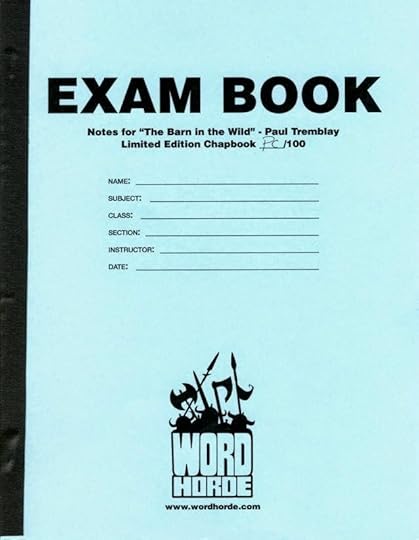
My copy is not numbered but is rather a "PC" copy -- a Presentation Copy that I received as one of the book's contributors. Now here's a behind-the-scenes peek at the publisher hand-assembling the chapbook:
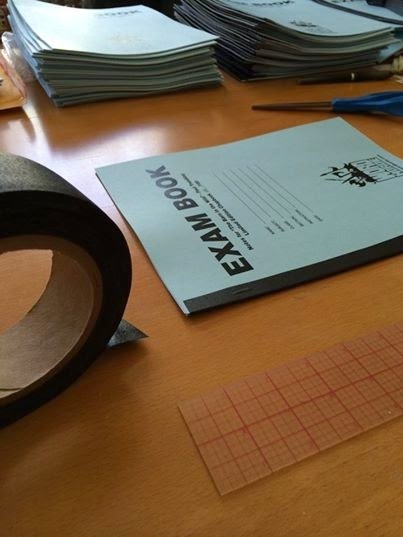
The Deluxe Pack also came with a Word Horde bookplate signed by both TCoOL editors, Ross E. Lockhart and Justin Steele:
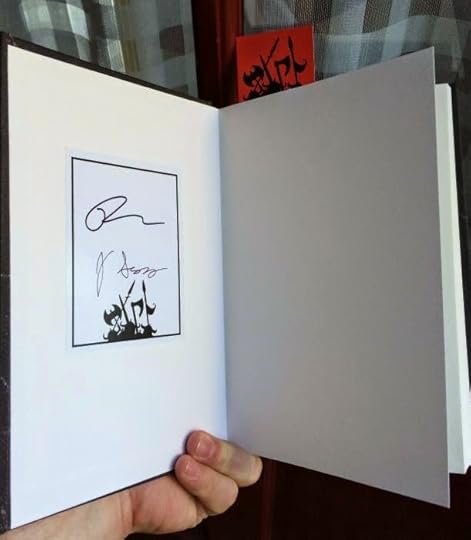 The hand holding the book is courtesy
The hand holding the book is courtesyof Ross E. Lockhart. Thanks, Ross!
Other goodies included bookmarks, stickers, and postcards....And, to top it off, the Deluxe Pack also included an ebook edition of the anthology, in the reader's format of choice.

Published on July 05, 2014 09:17
July 1, 2014
Charles Stross's The Rhesus Chart: "Pounce!"
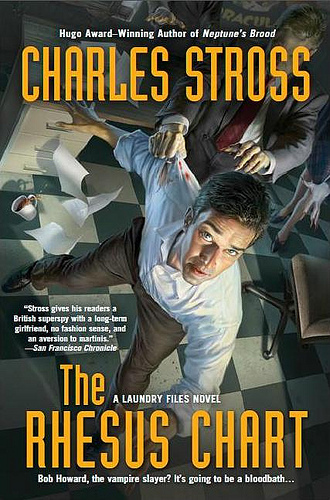 Today -- July 1 -- is the publication date for
The Rhesus Chart
Today -- July 1 -- is the publication date for
The Rhesus Chart
 , the fifth in the Laundry Files series by Charles Stross.
, the fifth in the Laundry Files series by Charles Stross.How the first two Laundry Files books came to be published by Golden Gryphon Press I have written about at length in my blog post of December 10, 2009. But suffice to say that when Charlie and I first met, albeit briefly, at the ConJosé WorldCon in 2002, I asked for an original novella, and Charlie offered me a novel that crossed so many genres that his agent, he said, didn't know what to do with it. Fortunately, I did, and the rest, as they say, is Laundry Files history. The Atrocity Archives
 turned out to be an ideal book for a small press publisher. The first print run of 3,000 hardcovers sold out in about three months, so the book had a second hardcover printing. Not too shabby for a small press that was then publishing six hardcovers per year.
turned out to be an ideal book for a small press publisher. The first print run of 3,000 hardcovers sold out in about three months, so the book had a second hardcover printing. Not too shabby for a small press that was then publishing six hardcovers per year.I've been fortunate to have worked on all five Laundry Files novels, even when book 3, The Fuller Memorandum
 , was acquired and published by Ace Books. I've written about all three Ace Laundry Files novels within this blog, but you may find of special interest (especially if you are a writer) my blog post of exactly two years ago, on The Apocalypse Codex, entitled "Doing Charles Stross's Laundry with Style."
, was acquired and published by Ace Books. I've written about all three Ace Laundry Files novels within this blog, but you may find of special interest (especially if you are a writer) my blog post of exactly two years ago, on The Apocalypse Codex, entitled "Doing Charles Stross's Laundry with Style."But back to The Rhesus Chart... How can you go wrong with a novel that opens with the following line:
"Don't be silly, Bob," said Mo, "everybody knows vampires don't exist."
The Rhesus Chart was recently graced with a starred Kirkus review. Let me repeat that: a starred Kirkus review. A review by Kirkus is difficult enough to come by, but a starred review? Now that's a treat. The review was posted online on June 5 and appeared in the June 15 issue of Kirkus Reivews. Here's a taste:
Fast-tracked into management after recent successes, Bob grows suspicious when a whiz-kid team of investment bankers which calls itself the Scrum discovers an algorithm that promises to make its members billions in profits but whose unfortunate side effect...is to turn them into vampires. (The supreme irony of this will be lost on few readers.) An added complication for Bob is that the Scrum's ringleader, Mhari Murphy, is an ex-girlfriend. More peculiar yet, why is everybody in the Laundry convinced that vampires don't exist? Bob's superiors take prompt action—and form a committee. Laundry regulars by now will be familiar with Stross' trademark sardonic, provocative, disturbing, allusion-filled narrative. And, here, with a structure strongly reminiscent of Len Deighton's early spy novels, the tone grows markedly grimmer, with several significant casualties and tragedies, perhaps in preparation for Angleton's [Bob's superior] feared CASE NIGHTMARE GREEN.
Stross at the top of his game—which is to say, few do it better. Pounce!
Courtesy of the author Charles Stross and Ace Books, the entire first chapter of The Rhesus Chart has been posted online for your reading pleasure. If you are unfamiliar with the Laundry Files tales, The Rhesus Chart is actually a good place to start.

Published on July 01, 2014 07:23

